- Gas-discharge lamp
-
See also: Gas-filled tube
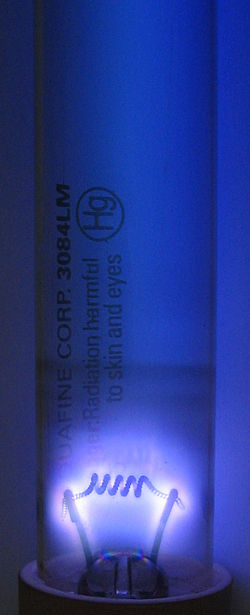 Germicidal lamps are simple low pressure mercury vapor discharges in a fused quartz envelope.
Germicidal lamps are simple low pressure mercury vapor discharges in a fused quartz envelope.
Gas-discharge lamps are a family of artificial light sources that generate light by sending an electrical discharge through an ionized gas, i.e. a plasma. The character of the gas discharge critically depends on the frequency or modulation of the current: see the entry on a frequency classification of plasmas. Typically, such lamps use a noble gas (argon, neon, krypton and xenon) or a mixture of these gases. Most lamps are filled with additional materials, like mercury, sodium, and/or metal halides. In operation the gas is ionized, and free electrons, accelerated by the electrical field in the tube, collide with gas and metal atoms. Some electrons in the atomic orbitals of these atoms are excited by these collisions to a higher energy state. When the excited atom falls back to a lower energy state, it emits a photon of a characteristic energy, resulting in infrared, visible light, or ultraviolet radiation. Some lamps will convert the ultraviolet radiation to visible light with a fluorescent coating on the inside of the lamp's glass surface. The fluorescent lamp is perhaps the best known gas-discharge lamp.
Gas-discharge lamps offer long life and high efficiency, but are more complicated to manufacture, and they require electronics to provide the correct current flow through the gas.
Contents
History
The history of gas-discharge lamps began in 1675 when French astronomer Jean-Felix Picard observed that the empty space in his mercury barometer glowed as the mercury jiggled while he was carrying the barometer.[1] Investigators, including Francis Hauksbee, tried to determine the cause of the phenomenon. Hauksbee first demonstrated a gas-discharge lamp in 1705. He showed that an evacuated or partially evacuated glass globe, in which he placed a small amount of mercury, while charged by static electricity could produce a light bright enough to read by. The phenomenon of electric arc was first described by Vasily V. Petrov, a Russian scientist, in 1802; Sir Humphry Davy demonstrated in the same year the electric arc at the Royal Institution of Great Britain. Since then, discharge light sources have been researched because they create light from electricity considerably more efficiently than incandescent light bulbs.
Later it was discovered that the arc discharge could be optimized by using an inert gas instead of air as a medium. Therefore noble gases neon, argon, krypton or xenon were used, as well as carbon dioxide historically.
The introduction of the metal vapor lamp, including various metals within the discharge tube, was a later advance. The heat of the gas discharge vaporized some of the metal and the discharge is then produced almost exclusively by the metal vapor. The usual metals are sodium and mercury owing to their visible spectrum emission.
One hundred years of research later led to lamps without electrodes which are instead energized by microwave or radio frequency sources. In addition, light sources of much lower output have been created, extending the applications of discharge lighting to home or indoor use.
Color
Each gas, depending on its atomic structure emits certain wavelengths which translates in different colors of the lamp. As a way of evaluating the ability of a light source to reproduce the colors of various objects being lit by the source, the International Commission on Illumination (CIE) introduced the color rendering index. Some gas-discharge lamps have a relatively low CRI, which means colors they illuminate appear substantially different than they do under sunlight or other high-CRI illumination.
Gas Color Spectrum Notes Image Helium White to orange; under some conditions may be gray, blue, or green-blue. 
Used by artists for special purpose lighting. 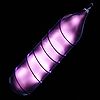
Neon Red-orange 
Intense light. Used frequently in neon signs and neon lamps. 
Argon Violet to pale lavender blue 
Often used together with mercury vapor. 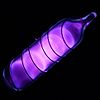
Krypton Gray off-white to green. At high peak currents, bright blue-white. 
Used by artists for special purpose lighting. 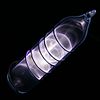
Xenon Gray or blue-gray dim white. At high peak currents, very bright green-blue. 
Used in flashbulbs, xenon HID headlamps, and xenon arc lamps. 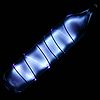
Nitrogen Similar to argon but duller, more pink; at high peak currents bright blue-white. 
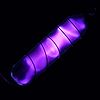
Oxygen Violet to lavender, dimmer than argon 
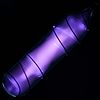
Hydrogen Lavender at low currents, pink to magenta over 10 mA 
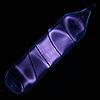
Water vapor Similar to hydrogen, dimmer Carbon dioxide Blue-white to pink, in lower currents brighter than xenon Used in Carbon Dioxide Lasers. 
Mercury vapor Light blue, intense ultraviolet 
Ultraviolet not shown
In combination with phosphors used to generate many colors of light. Widely used in mercury-vapor lamps. 
Sodium vapor (low pressure) Bright orange-yellow 
Widely used in sodium vapor lamps. 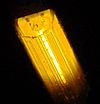
Types of gas-discharge lamps
Low pressure discharge lamps
Low-pressure lamps have working pressure much less than atmospheric pressure. For example common fluorescent lamps operate at a pressure of about 0.3% of aspmospheric pressure.
- Fluorescent lamps, the most common lamp in office lighting and many other applications, produces up to 100 lumens per watt
- Low pressure sodium lamps, the most efficient gas-discharge lamp type, producing up to 200 lumens per watt, but at the expense of very poor color rendering. The almost monochromatic yellow light is only acceptable for street lighting and similar applications.
High pressure discharge lamps
High-pressure lamps have a discharge that takes place in gas under slightly less to greater than atmospheric pressure. For example, a high pressure sodium lamp has an arc tube under 100 to 200 torr pressure, about 14% to 28% of atmospheric pressure; some automotive HID headlamps have up to 50 bar or fifty times atmospheric pressure.
- Metal halide lamps. These lamps produce almost white light, and attain 100 lumen per watt light output. Applications include indoor lighting of high buildings, parking lots, shops, sport terrains.
- High pressure sodium lamps, producing up to 150 lumens per watt. These lamps produce a broader light spectrum than the low pressure sodium lamps. Also used for street lighting, and for artificial photoassimilation for growing plants
- High pressure mercury-vapor lamps. This lamp type is the oldest high pressure lamp type, being replaced in most applications by the metal halide lamp and the high pressure sodium lamp.
High-intensity discharge lamps
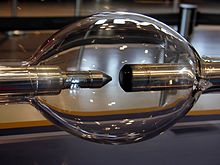 15 kW xenon short-arc lamp used in IMAX projectors
15 kW xenon short-arc lamp used in IMAX projectors Main article: High-intensity discharge lamp
Main article: High-intensity discharge lampA high-intensity discharge (HID) lamp is a type of electrical lamp which produces light by means of an electric arc between tungsten electrodes housed inside a translucent or transparent fused quartz or fused alumina arc tube. Compared to other lamp types, relatively high arc power exists for the arc length. Examples of HID lamps include:
- Mercury-vapor lamps
- Metal halide lamps
- Ceramic discharge metal halide lamps
- Sodium vapor lamps
- Xenon arc lamps
- Ultra-High Performance (UHP)
HID lamps are typically used when high levels of light over large areas are required, and when energy efficiency and/or light intensity are desired.
Other examples
- Neon signs may use either direct illumination or, to obtain certain colors, indirect phosphor excitation.
- Xenon flash lamp. This lamp is commonly found in film and digital cameras, even in single-use cameras. These lamps have produced interesting illumination effects in theatre and dancing. More robust versions of this lamps, known as strobe lights, can produce short intense flashes repeatedly, allowing the stroboscopic examination of repetitive motion (useful in certain balancing applications). These were at one time popular, "freezing" the motion of the actors or dancers. This type of lamp was also used to demonstrate persistence of vision, where an entire room would be illuminated by multiple lamps behind diffusing wall panels. In this otherwise darkened room a periodic flash would cause every detail of the occupants to be imaged on the observer's retina, completely frozen in motion.
See also
- Electric glow discharge
- Electric arc
- Emission spectrum
- Fluorescent lamp
- Gas-filled tube
- Hydrargyrum medium-arc iodide lamp
- List of light sources
- Over-illumination
References
- ^ See Wikipedia's article: Barometric light.
Further reading
- Waymouth, John (1971). Electric Discharge Lamps. Cambridge, MA: The M.I.T. Press. ISBN 0-262-23048-8.
- National Highway Traffic Safety Administration. "Glare from headlamps and other front mounted lamps". Federal Motor Vehicle Safety Standard No. 108. US Department of Transportation. http://www.nhtsa.gov/cars/rules/rulings/glare.html. Retrieved 2006-01-23.
External links
Lamps and lighting Incandescent Fluorescent High-intensity
discharge (HID)Mercury-vapor · Hydrargyrum medium-arc iodide (HMI) · Hydrargyrum quartz iodide (HQI) · Metal halide (Ceramic) · Sodium vaporGas discharge Deuterium arc · Neon · Sulfur · Xenon arc / Xenon flash · Black light · Tanning lamp · Germicidal · Growth lightElectric arc Combustion Other Lamp (electrical component) · Light fixture · Lightbulb sockets · Light-emitting diode (LED) · LED lamp · Solid-state (SSL) · Plasma · Electroluminescent wire · Chemiluminescence · Radioluminescence · Glow stick · ESLCategories:- Gas discharge lamps
- Light sources
Wikimedia Foundation. 2010.

